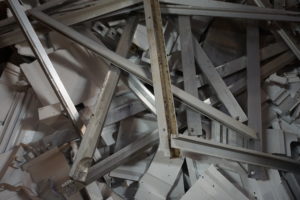Ask the average American to define metal and you might hear the words “steel,” “magnetic” and “strong.” But unless you’re talking to someone who works in the recycling or manufacturing industry, you probably won’t hear the words “ferrous” or “non-ferrous.” That’s because many people don’t realize that all metals fall into one of these two categories. Their names are derived from ferrum, the Latin word for iron. Whether a metal is ferrous determines its recycling potential, so the distinction is important.
Differences Between Metals
As you would likely guess, ferrous metals contain iron. That property makes most of these metals magnetic. Some of the most common and widely-known ferrous metals are steel, light iron, cast iron and wrought iron, although they may be coated by non-ferrous materials. Scrapped vehicles are a major source of ferrous metals.
Non-ferrous metals aren’t metallic because they don’t contain significant amounts of iron. Aluminum, lead, copper, tin, zinc and brass (an alloy of copper and zinc) are all non-ferrous. Precious metals like gold and silver fall into this category, too.
The two types of metal differ when it comes to prices. Although ferrous metals are recycled in far greater quantities, non-ferrous metals are worth more money. Copper, tin and precious metals are especially valuable. Ferrous metals are so readily available that they don’t command as high a price, either in their virgin state or as scrap.
Recycling and Metals
One of the downsides of ferrous metals, at least from a recycling perspective, is that they’re susceptible to corrosion and not always salvageable. Not all ferrous materials are at risk; whether a given type of metal corrodes depends on what elements it’s mixed with. A ferrous alloy is typically more resistant to rust and staining than, say, carbon steel.

By contrast, non-ferrous metals are incredibly durable and don’t degrade over time. The same is only true for some ferrous metals.
Both types of metals can be processed and recycled in roughly the same way. Powerful magnets separate the magnetic metals from nonferrous metals. Metals may be sorted further and are then shredded or sheared into smaller pieces. More magnets separate out any smaller pieces of ferrous metals. From there, the pieces may be melted and formed into new shapes, or baled into large blocks.
We handle only some of these steps in-house at Miller Recycling.
Some of our customers are surprised to hear that we ship some of our recyclable materials, including metals, to other countries for processing. Although metals are heavy, transporting them great distances on container ships is actually cheaper than transporting them by truck, which allows us to offer competitive prices for scrap metal. It allows us to continue to operate locally, too.
We buy both ferrous and nonferrous scrap metal at Miller Recycling. Contact us to talk specifics.

